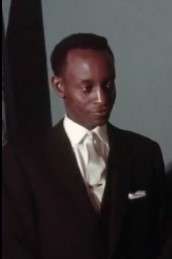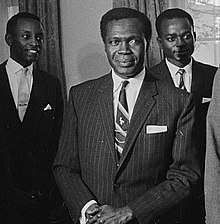Grace Ibingira
Grace Stuart Katebariirwe Ibingira (23 May 1932 – December 1995) was a Ugandan lawyer and politician.
Grace Ibingira | |
|---|---|
 Grace Ibingira at the United Nations Headquarters, October 1962 | |
| Minister of Information of Uganda | |
| In office 7 June 1979 – 19 June 1979 | |
| Personal details | |
| Born | May 23, 1932 Ibanda County, Ankole District, Uganda Protectorate |
| Died | December 1995 |
| Political party | Uganda People's Congress |
Early life
Grace Ibingira was born on 23 May 1932 in Ibanda County, Ankole District, Uganda Protectorate. His father, Alfred Katebarirwe, was a Gombolola chief. From 1942 until 1950 he attended Mbarara High School. The following year he enrolled in King's College Budo. He graduated in 1953 with a grade one Cambridge School Certificate. Subsequently taking up the study of law, he graduated in 1958 magna cum laude from the University College Wales, Aberystwyth. Ibingira finished his studies in 1959 with a year of postgraduate work at the University of London. He was then called to the bar by Middle Temple, being listed as a barrister of the Supreme Court of England. That same year he went to Kampala to serve as an advocate for the Uganda High Court.[1]
Political career
Entry into politics
For a time, Ibingira served as the legal adviser for the Uganda People's Congress (UPC), a political party.[2] Throughout his political career, Ibingira was primarily preoccupied by gaining power. He was vague about his beliefs, and only publicly committed himself to ones that had widespread acceptance. Instead of garnering popular appeal, he advanced his position through negotiations and private discussions with other leaders.[3] His political support derived from four areas: the UPC political machine based in Ankole, southern municipal and district politicians who felt threatened by UPC leader Milton Obote's populist appeal, conservative intellectuals who found Obote's image drab and unimpressive, and Edward Mutesa, the Kabaka (king) of Buganda.[4]
Ugandan independence

Ibingira was elected to the Uganda Legislative Council in 1960 by the Ankole Eishengyero (district council).[1] The Democratic Party (DP) won a majority in Uganda's first free national elections in 1961, and formed a government. The UPC members and traditionalist Baganda disliked the Catholic orientation of the DP, but were diametrically opposed to each others' ideals.[5] Despite this, Ibingira was given the responsibility of making contact with the Baganda to establish an alliance. The UPC chose him for the role because he was personally acquainted with Mutesa. After several negotiations, the UPC and Baganda leaders held a conference whereupon an agreement was reached. Soon afterwards the Baganda created the Kabaka Yekka (KY), a traditionalist party that entered an alliance with the UPC.[6] Following the UPC's victory in the April 1962 general elections, Obote was tasked with forming a government.[7] He chose Ibingira to serve as Minister of Justice.[8] Ibingira also played an influential role in determining the look of the Flag of Uganda, chairing a committee charged with drafting a design and suggesting that the standard be modeled off of the West German Flag.[9] Uganda became independent on 9 October 1962.[7]
Rivalry with Obote

Ibingira felt that Obote was not educated enough to serve as Prime Minister of Uganda and believed that he had been given the position solely because of his anti-colonial rhetoric.[10] In 1964 Ibingira initiated a struggle to gain control of the UPC with the ultimate goal of deposing Obote from the party presidency.[11] At a party conference in April he challenged John Kakonge for the secretariat-general of the UPC. He convinced Obote that Kakonge posed a threat to his leadership of the UPC. With Obote's support, Ibingira ousted Kakonge by two votes.[12] He used his new position to purge the party of a number of leftists.[11]
Meanwhile, Mutesa increasingly feared that the UPC would deny his kingdom its traditional autonomy. He concluded that in order to retain power he would have to garner influence in national politics. Mutesa proceeded to instruct Baganda MPs to join the UPC with the goal of bolstering Ibingira's position and unseating Obote, thus allowing for a reorientation of the UPC-KY alliance that would be more favorable to Buganda.[13] As his working relationship with Mutesa improved, Ibingira amassed a coalition of non-Baganda southerners, dubbed the "Bantu Group".[14] In December 1964 he, under the cover checking on his ranch in Ankole, traveled to the United States to raise funds to support anti-socialist causes. Upon his return, he successfully used the money to expand his following.[10] The following year Ibingira played a key role in passing an amendment to the Police Ordinance through Parliament that allowed the police to disperse any public meeting or assembly. By then it was apparent that the UPC had divided into an Ibingira-led wing and an Obote-led wing. When Ibingira attempted to convene a UPC conference in his capacity as party secretary general, the police—acting under the authority of the new statute—shut it down.[15]
In early 1966 a banker leaked the financial records of Idi Amin, a soldier in the Ugandan army who had close ties with Prime Minister Obote. The documents implicated Amin in illicit gold trafficking along the Democratic Republic of the Congo border. A motion tabled in Parliament charged Amin with corruption and accused Obote of being complicit in his actions.[16] The UPC resolved to reject it. However, on 4 February, while Obote was away from Kampala, the capital, Ibingira convinced the cabinet to recognise the complaint.[17] When Obote returned eleven days later, he was unable to dissuade his ministers from proceeding with an investigation. The cabinet attempted to convene on 22 February to appoint a commission of inquiry into the matter, but Obote had the police interrupt the meeting and place Ibingira and four other ministers under arrest.[16][18] They were transferred to Karamoja as per a colonial law that allowed for the detention and removal of "undesirable" persons. Ibingira and the ministers petitioned the courts for a writ of habeas corpus. A Uganda High Court judge found the detention legal and denied the petition, but the East African Court of Appeal ruled that the relevant law violated a Ugandan citizen's constitutional right to freedom of movement and ordered a writ of habeas corpus to be granted. Ibingira and his colleagues were immediately rearrested outside the court in Baganda under the colonial Emergency Regulations and the government passed the Deportation Act to cover its actions. Ibingira and the other ministers filed a new suit, but in a hearing the court affirmed the legality of the new law.[19]
Post-Obote career
On 25 January 1971 Amin launched a military coup, ousting Obote and seizing power. He released Ibingira along with 54 other political prisoners and appointed him Ambassador and Permanent Representative to the United Nations.[20] Ibingira later went into exile. When a Tanzanian invasion threatened the Ugandan regime, he promoted Yusuf Lule as a potential successor to Amin.[21] Ibingira attended the Moshi Conference in March 1979 where Ugandan exiles elected Lule to succeed Amin once he was deposed.[22] Lule appointed Ibingira Minister of Information on 7 June 1979.[23] His addition to the cabinet particularly upset the National Consultative Committee.[24] On 19 June Lule removed Ibingira from his cabinet and made him Ambassador to the UN.[25]
In 1980 Ibingira published a book, entitled, African Upheavals since Independence.[26] He died in December 1995.[27]
Citations
- Ibingira 1973, p. ix.
- Mutibwa 1992, p. 54.
- De La Rue 1966, p. 207.
- De La Rue 1966, p. 208.
- Karugire 1980, pp. 179–181.
- Karugire 1980, pp. 182, 186.
- Karugire 1980, p. 188.
- "Ugandan Personalities through the years from 1962". Eagle Online. 8 June 2015. Retrieved 23 December 2018.
- "Intrigue and manoeuvres in designing the Uganda flag". New Vision. 4 July 2012. Retrieved 21 November 2018.
- Ingham 1994, p. 100.
- Kasozi 2013, p. 46.
- De La Rue 1966, pp. 207–208.
- Kasozi 2013, p. 47.
- The rise and fall of Grace Ibingira 1967, p. 25.
- Karugire 1980, p. 195.
- Kasozi 2013, p. 48.
- Ingham 1994, p. 106.
- The rise and fall of Grace Ibingira 1967, p. 28.
- Oloka-Onyango 2017, pp. 41–42.
- Karamura 1998, pp. 113, 120.
- Avirgan & Honey 1983, p. 108.
- Avirgan & Honey 1983, pp. 113, 117.
- Kasozi 1994, p. 131.
- Lubega, Henry (16 June 2019). "How Prof Yusuf Lule's 68-day reign came crashing down". Daily Monitor. Retrieved 27 March 2020.
- Winfrey, Carey (20 June 1979). "Ugandan Cabinet Shuffled Again In Effort to Strike Tribal Balance". The New York Times. p. A4.
- Mutibwa 1992, p. 42.
- Kahigiriza 2001, p. 36.
References
- Avirgan, Tony; Honey, Martha (1983). War in Uganda: The Legacy of Idi Amin. Dar es Salaam: Tanzania Publishing House. ISBN 978-9976-1-0056-3.CS1 maint: ref=harv (link)
- Ibingira, G.S.K. (1973). The forging of an African nation: the political and constitutional evolution of Uganda from colonial rule to independence, 1894-1962. New York: Viking Press. OCLC 1037103920.CS1 maint: ref=harv (link)
- Ingham, Kenneth (1994). Obote : A political biography. New York & London: Routledge. ISBN 9780415053426.CS1 maint: ref=harv (link)
- Kahigiriza, James (2001). Bridging the Gap: Struggling Against Sectarianism and Violence in Ankole and Uganda. Kampala: Fountain Publishers. ISBN 9789970022762.CS1 maint: ref=harv (link)
- Karamura, Grace Patrick (December 1998). The interplay of Christianity, Ethnicity and Politics in Ankole, Uganda, 1953-1993 (PhD). University of Leeds. OCLC 757050530.CS1 maint: ref=harv (link)
- Karugire, Samwiri Rubaraza (1980). A Political History of Uganda. Nairobi: Heinemann Educational Books. ISBN 9780435945244.CS1 maint: ref=harv (link)
- Kasozi, A. (1994). Social Origins of Violence in Uganda, 1964-1985. McGill-Queen's Press. ISBN 9780773564879.CS1 maint: ref=harv (link)
- Kasozi, A.B.K. (2013). The Bitter Bread of Exile. The Financial Problems of Sir Edward Mutesa II during his final exile, 1966 - 1969: The Financial Problems of Sir Edward Mutesa II during his final exile, 1966 - 1969 (reprint ed.). Progressive Publishing House. ISBN 9789970464005.CS1 maint: ref=harv (link)
- Mutibwa, Phares Mukasa (1992). Uganda Since Independence: A Story of Unfulfilled Hopes. Africa World Press. ISBN 9780865433571.CS1 maint: ref=harv (link)
- Oloka-Onyango, J. (2017). When Courts Do Politics: Public Interest Law and Litigation in East Africa. Cambridge Scholars Publishing. ISBN 9781443864091.CS1 maint: ref=harv (link)
- "The rise and fall of Grace Ibingira : Part Two". The New African. 6 (1): 24–27. March 1967. ISSN 0470-8504.
- De La Rue, Andre (December 1966). "The rise and fall of Grace Ibingira". The New African. 5 (10): 207–208. ISSN 0470-8504.CS1 maint: ref=harv (link)